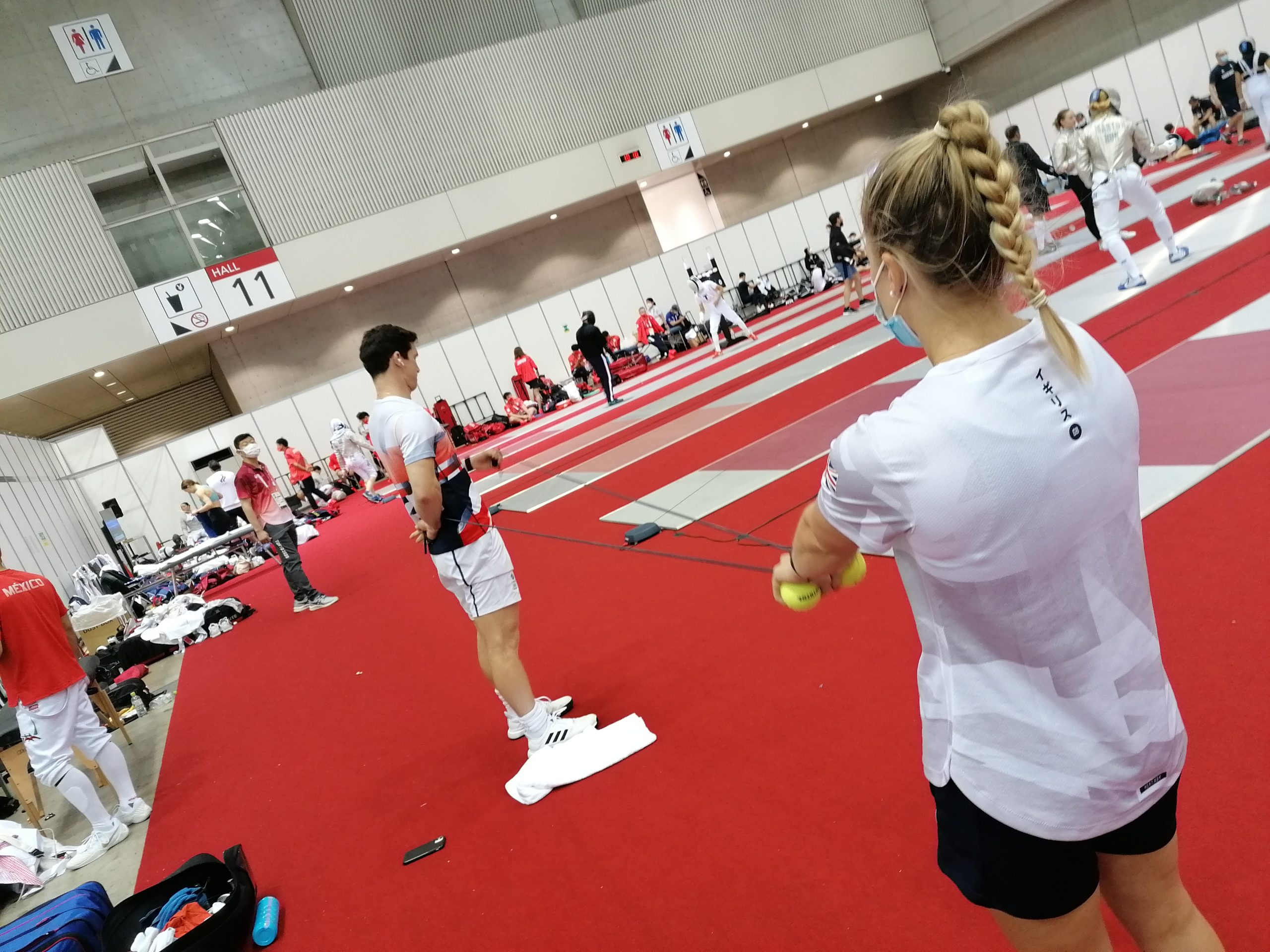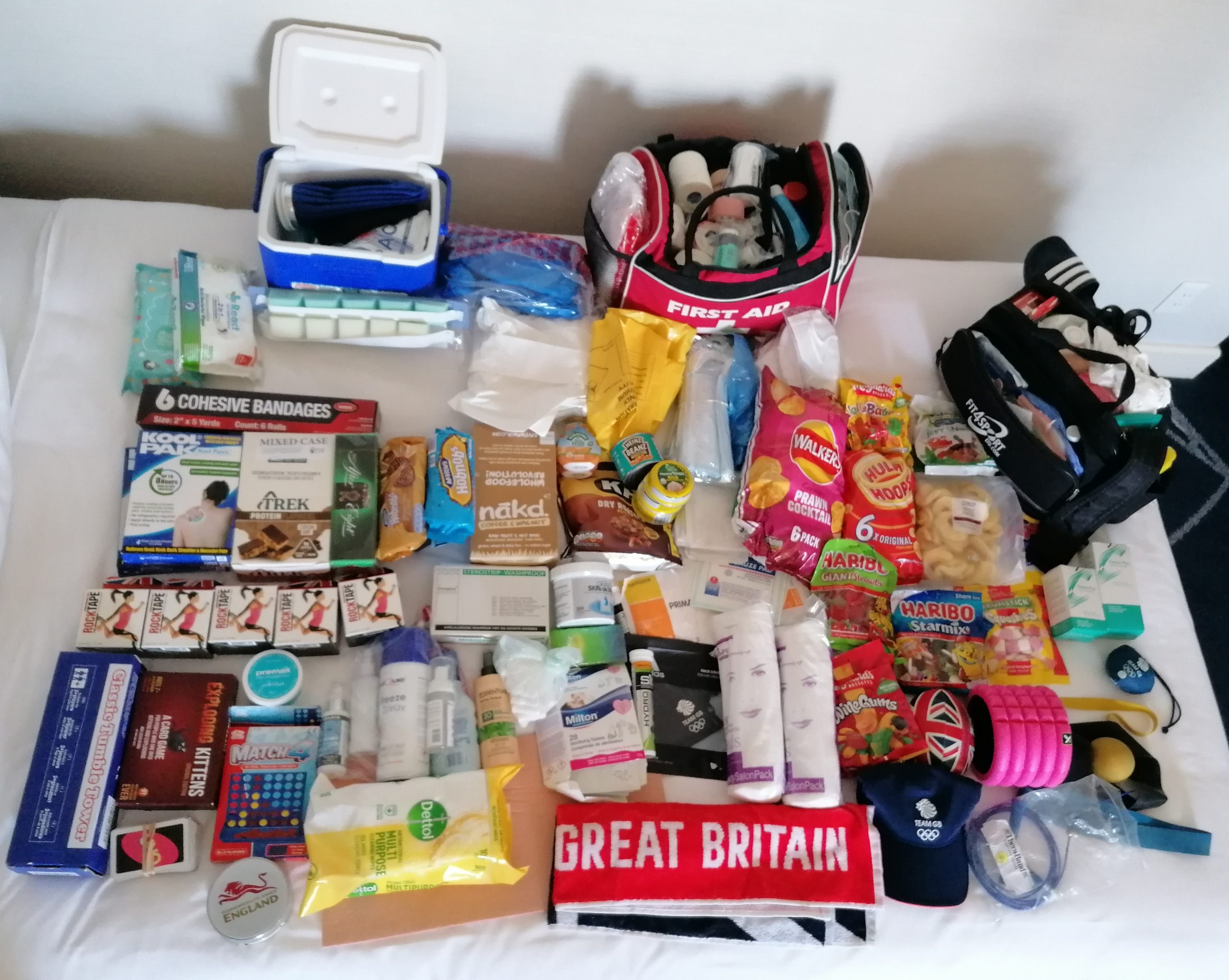
With the global pandemic of COVID 19 still going on we had a lot of protocols and health monitoring before we even left for Tokyo, including a PCR test 14days, 96 hours and 72 hours before we departed. I won’t touch too much on COVID as it’s definitely not the most exciting part of this competition but to fulfil anyone’s curiosity we had 2 daily health monitoring apps, daily saliva tests and all the normal protocols around the prep camp and Olympic village – social distancing, mask, hand sanitising etc whilst in Japan. Although some of the press like to deem this the ‘COVID Olympics’ all this has become part and parcel of life, and life in high performance sport over the last 18months so it didn’t feel anything out of the normal.
Now on to the fun stuff!… Team GB are an incredibly well-run organisation and made everything run so smoothly from departure to competition. They also left no-stone unturned to make sure the athletes and staff were looked after to the highest of standards. What Team GB are world class at, is doing all of this whilst making everyone feel part of one big team.

Mobility room at the team GB hotel

Training facilities at Keio University
Our first week in Japan was spent in Yokohama at the Team GB ‘Preparation camp’. This is where athletes can spend time getting acclimatised to the time zone, weather and carry on their training pre-competition. We stayed at a hotel and as part of our sports ‘bubble’ we could go to train at Keio University which had been set up for many of the Olympic sports. One of my favourite things about this training set-up was that we were in a multi-sport environment where our training took place in the same hall as boxing, taekwondo, badminton and table tennis. It was great to have such a melting pot of the best athletes, coaches and support staff in the world, right in one room. Not only was this great for athletes to see others train and get the buzz off each other but it also meant that as a practitioner I could also learn from how other sports and staff
approach their training. It was also an opportunity for me to connect with physios, coaches and athletes from across a wide range of sports. When working at the high-performance level, at any level as a physio, I believe that having a growth mindset and always trying to learn from different environments and people is one of the most important things.

Team GB Physio room, Odaiba School
During our training at ‘prep camp’ we completed sport-specific training, including a competition simulation day, gym training, bike recovery, mobility, hydrotherapy, and treatment sessions. Both the hotel and university had amazing facilities for recovery, including large physio rooms with mobility areas. I always make sure we book into these facilities to give some variation to the athletes’ days, as well as giving both myself and the athletes opportunities to mix with other members of Team GB, and of course to aid their performance and recovery. This is all part of the experience and both can learn from these environments and informal conversations that can be had there.

Team GB Performance Lodge Training
After ‘prep camp’ we moved to the Olympic Village. This time we had access to the Team GB performance lodge at Odaiba School, where again there was a full strength and conditioning gym, swimming pool, ice baths, physio room, mobility areas, dining hall, lounge areas, outdoor chillout areas, media areas and of course sport-specific training settings. Much like ‘prep camp’ it’s a great multi-sport experience where we may be doing hydrotherapy in the pool while the GB tennis squad are using the ice baths, we’re eating lunch while the GB boxers are watching their teammates compete on the TV and where the staff and volunteers are always there to help you in any way they can, always with a smile of course.

Views from the GB block
The Olympic Village was nothing short of amazing with so many athletes from so many nations all visiting the Olympic rings for photos, sitting eating their food in the dining hall and cycling around on their various team bikes. We had Brompton bikes outside our accommodation block, which was a great way to see the village, get some exercise in and save time on the feet, another small touch Team GB thought of with the athletes’ performance in mind.

Night-time in the Olympic Village
One of my favourite days in the Olympic Village was the evening of the Opening ceremony, our team manager and athlete, Marcus Mepstead, both had golden tickets to this event. Due to COVID19 not many Team GB athletes had the opportunity to attend this event and a lot of teams skipped the ceremony as they were competing in the days following the ceremony. Despite only 16 athletes/staff heading off to the Opening Ceremony the whole of Team GB dressed up in their ceremony kit and we celebrated the start of the Tokyo ‘2020’ Olympics out in the garden in front of the Team GB block. It was such a melting pot of athletes and staff, a very special time. We celebrated the two flag bearers, Hannah Mills (Sailing) and Mo Sbihi (Rowing), took photos with each other and it also gave me a great opportunity to catch up with old colleagues and athletes from the various sports.
Watching the Opening Ceremony from the Team GB block and seeing the fencing team on the TV, in such a strange time and a unique opening ceremony was a great privilege, definitely a proud moment after the 5 years of hard work everyone had put in to even get to this Olympic Games.

GB Fencing Team at the Opening Ceremony
My physio strategies at the Olympic Games:
Here are a few snippets of how I approach major competitions and events in high-performance sport, as a physio…
+ Pre-travel and competition athlete health monitoring – making sure the athletes get on the plane fresh, fit and well, and recovered

Light aerobic activity on the travel protocol +15pts
+ Having a travel protocol in place – at British Fencing we designed a point system with the athletes to show how which strategies may help aid their acclimatisation e.g. mobility session on arrival +10pts, physio check-in +10pts, <6hrs sleep -5pts
+ Jetlag strategy – very important for Tokyo with an +8hr time difference!
+ Physio and recovery sessions – making sure mobility rooms, physio couches, hydrotherapy session are all booked in advance and put in the athletes’ training schedule (we are also flexible with these and mould as needed day by day)
+ Bring all the kit – making sure I have all that I will need while away including travel couch, physio kit supplies, PPE. One of my biggest values as a physio, and something I try to impart on the athletes, is to be responsible and accountable for yourself and needs because you never know if others will be able to provide supplies etc once you’re away, it’s always a bonus if they do!
+ Keep in touch with the support team at home – it’s really important to keep in touch with the support team that haven’t travelled, for us this is the S+C coach, Dr, admin staff. It’s always good to lean on these team members for support and different perspectives, especially when it can get quite absorbing whilst in the midst of competition
+ Downtime – Not only is it important to schedule all the training and activities at the Olympic Games but it is important for us to schedule downtime for everyone during these major competitions. They can be intense, tiring, emotional, exciting and busy, so leaving gaps in the schedule for the team to relax and spend time away from training are really needed
Common Rehab, Recovery and Injury prevention Strategies in Fencing:
+ Bullet proofing shoulders- lots of grip, forearm, postural control and single arm use means maintaining resilient shoulders is important
+ Grip strength testing – to monitor CNS fatigue and any changes that may impact fencing technical quality

Bulletproof shoulder warm-up
+ Plyometrics – high speed and power needs in fencing can take its toll on the tendons so it’s important to train these off-the-piste e.g. broad jumps, single leg hops
+ Ankle stability drills – lateral ankle sprains can be common in fencing, there is little agility involved which can leave ankles vulnerable when moving up and down the piste so we try to add in ankle stability sand change of direction drills in the warm-ups to provide proprioceptive awareness

Prep-camp Pool Hydro
+ Hydrotherapy – offloading the body’s weight in water is a perfect post-training/match recovery strategy, it’s also great for light exercise, stretching and mobility
+ Soft Tissue Therapy – the preferred recovery and maintenance therapy for most of our athletes, common treatment areas include the quads, TFL, Glutes, lower back, forearm, neck and shoulders
+ Yoga and mobility sessions – these are particularly good to run post-travel or on rest days as it can help the athletes reset any tension in their bodies whilst checking in mentally, doing some mediation and it can also be a nice way to check in with the athletes in an informal setting
What’s in my Olympic Games Physio bag?…
ROCKTAPE
This is one of my favourite brands and tapes to use. It sticks well to the skin, is flexible, light and comes in some cool patterns, we love the Union Jack rolls at Fencing!
On a serious note, I have used many K-tapes in the past and Rocktape is the only I will use now. From the days of taping International Crossfitters to working with school sports to GB athletes this tape is bulletproof. It is versatile and has many amazing uses, here are a few ways I like use it:
+ Joint support
+ Swelling management
+ Muscle support after injury
+ Tendon inflammation
+ Pain management
+ Bruise management
+ Biofeedback and postural control
+ Finger protection e.g. avoiding blisters
+ Grip protection e.g. bar gymnastics
One of my particular preferences for Rocktape, is for swelling and bruising. Swelling and bruising are often associated with the acute phase of healing, the first 7-10days post-injury. Swelling can reduce the mobility around a joint or soft tissues. I use Rocktape from the initial time of injury and throughout this acute phase to help aid the return of fluid to the lymph system. The added benefit of the compressive nature of Rocktape and the flexibility that allows it to move with the skin and soft tissues is ideal for this purpose.
ROCKRUB and ROCKSAUCE – the majority maintenance and recovery treatments involve soft tissue therapy and these are good tools to get into sticky soft tissues
ROCKPODS – great for aiding the release of the thoracolumbar fascia post-fencing training
ROCKBLADE – great for use on the forearms of a high-performance fencer
ROCK BANDS – A vital piece of equipment when travelling and especially this year with so many hotel room gym sessions
Here’s a photo of the contents of most of my Olympic Games supplies:

Just some of the supplies I packed for the Olympics
-note snacks and nutrition are a serious addition, especially when visiting unfamiliar countries and if you think you may be stuck in isolation, food from home is always welcome. Although most of my snacks end up getting donated to athletes… Note 2: Take double the amount of snacks you think you will need because of this reason.
Maria Goriup
MSc, PgDip, HCPC, MCSP
British Fencing Physiotherapist
Tokyo 2020 Olympic Games